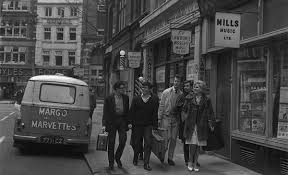Remembering Denmark Street in 1934…the Nanking Restaurant and the Indian Progressive Writers’ Association
Posted: January 6th, 2015 | 4 Comments »It seems that the usual combination of philistine developers and a venal local Council have decreed that London’s old Tin Pan Alley, Denmark Street, will be bulldozed. Though whole specialist streets have been awarded heritage preservation status in London (Hatton Garden and Saville Row for instance), Tin Pan Alley will not be preserved. As well as being the heart of the popular music industry in London the street actually dates back to the seventeenth century so the vandalism is massive. As a small contribution to memories of the road I’m here reposting a blog piece I put up a few years ago on the old Nanking Restaurant in Denmark Street that was one of the capital’s best known Chinese restaurants between the wars and also the place where the left wing Indian Progressive Writers’ Association was formed….
An interesting story involves the once well known the Nanking Restaurant on Denmark Street, off the Charing Cross Road. In November 1934 Indian activists in London (many later to become communists) including MD Taseer, Mulk Raj Anand, Jyoti Ghosh, Pramod Sengupta and Syed Sajjad Zahir met in a back room at the Nanking to form the left wing and anti-imperialist Indian Progressive Writers’ Association.The Nanking is often described as being in Soho (but is not, to me anyway, as it’s slightly east of Charing Cross Road) though Denmark Street was London’s original “Tin Pan Alleyâ€, though in 1932 the street was mostly Asian restaurants. Here’s a little more on the Nanking from The Queenslander newspaper in 1932 that reviewed the London Chinese restaurant scene….
“….enter Denmark Street, which is now almost wholly given over to Chinese and Japanese restaurants and emporia. Undoubtedly the most amusing of these places is The Nanking, presided over by Mr. Fung Saw. Mr. Fung is some thing of a politician, and to his restaurant come many of the more youthful of the budding Parliamentarians. These, together with composers and song writers, their publishers and film artists, comprise the chief of Mr. Fung’s clientele. The hall of feasting is reached by long, steep steps, which lead to an exceptionally large, light, and lofty basement. There is another and a mere prosaic entrance through a hall door on the ground floor, but somehow no one ever seems to notice it, and so we descend the more picturesque steps. Inside, the decorations are reminiscent of a Chinese junk, and the walls are decorated in vermilion and in greens and yellows, which only a Chinese artist is able to use to Oriental perfection. On the opposite side of the road are two Japanese restaurants, and just round the corner we can enter the banqueting hall of Wah Yeng, who contents himself with catering, to the exclusion of everything else. Mr. Yeng explained that he had a largo back room, which he reserved for Chinese business men, but as Chinese merchants do not so often come to London the hall at the back is usually thrown open to all.â€
Denmark Street in 1964 – by then the epicentre of the London music scene…

Thanks for this piece n the Nanking restaurant – I have made use of it, with acknowledgement and link, for a piece here http://www.andrewwhitehead.net/blog/downstairs-at-the-nanking-restaurant
At last! A little information about the NANKING, which I only know because it advertised regularly in the 1930s in the small ads in the Daily Worker and I keep seeing it and wondering. Example ad.
TRY A CHINESE DINNER
FOR A CHANGE – or your English / Dinner in CHINESE Surroundings / Best Cooking – Dinner from 1s. 3d./
Open 11.0 a.m. until 11.00 p.m. including Sundays/ NANKING CHINESE RESTAURANT / 4 DENMARK STREET opposite Foyle’s CHAR / ING CROSS ROAD, W.C.2 A Place for the /
Internationalist.”
“Internationalist” I now understand with several dimensions.
Thank you for posting.
A Chinese restaurant called the Universal Chinese Restaurant existed on the right hand side of Denmark Street as you entered from Charing Cross Road, near to the beginning of the street. I think it was circa 1955. The building is still there. The kitchen was on the top floor with dining floors below. The owner was a Chinese lady Mrs Leung (I hope I remember correctly). My parents and my sister and I attended a couple of gatherings there and visited the kitchens as we knew someone who worked there. There seems no record of it now or in any archive.
As a child I was occasionally taken to The Universal by my father who had an office in Southampton Place, Holborn. I looked it up on the Internet because I have nostalgic memories of what was, for me, an exciting experience, being taken to this bustling place in the otherwise somewhat austere streets of post-war London. The smell of Chinese food was so exotic to me as a seven year old boy that when I remember it my mouth still waters . There were busy Chinese waiters and a dumb waiter hoist from the kitchen that opened magically every minute or so to reveal yet another steaming dish. The restaurant was always packed at lunch time. My father told me that the waiters there called Guinness “Gooforyou”. Apparently Guinness was on the menu and their slightly misunderstood name for the stout came from the advertising strapline “Guinness is Good For You”. The Universal actually served Bird’s Nest Soup which was carried through to dinners with some ceremony, the birds nest, made of I know not what, sitting on top of the bowl with the aroma rising through it. As an adult I never returned to The Universal, its style and taste probably superseded by subsequent iterations of “Chinese” cuisine.